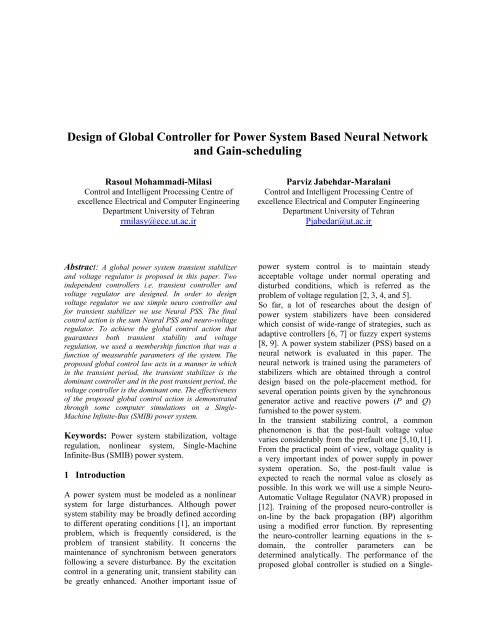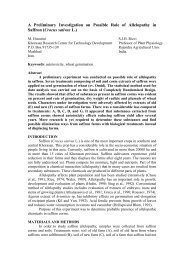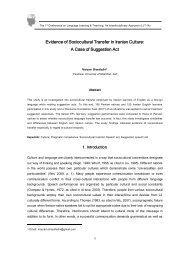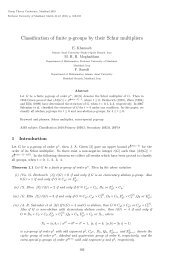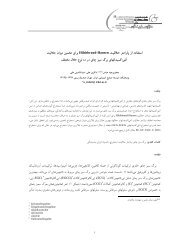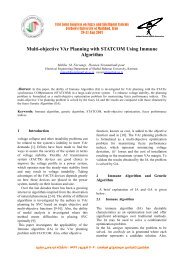Design of Global Controller for Power System Based Neural ...
Design of Global Controller for Power System Based Neural ...
Design of Global Controller for Power System Based Neural ...
You also want an ePaper? Increase the reach of your titles
YUMPU automatically turns print PDFs into web optimized ePapers that Google loves.
<strong>Design</strong> <strong>of</strong> <strong>Global</strong> <strong>Controller</strong> <strong>for</strong> <strong>Power</strong> <strong>System</strong> <strong>Based</strong> <strong>Neural</strong> Network<br />
and Gain-scheduling<br />
Rasoul Mohammadi-Milasi<br />
Control and Intelligent Processing Centre <strong>of</strong><br />
excellence Electrical and Computer Engineering<br />
Department University <strong>of</strong> Tehran<br />
rmilasy@ece.ut.ac.ir<br />
Abstract: A global power system transient stabilizer<br />
and voltage regulator is proposed in this paper. Two<br />
independent controllers i.e. transient controller and<br />
voltage regulator are designed. In order to design<br />
voltage regulator we use simple neuro controller and<br />
<strong>for</strong> transient stabilizer we use <strong>Neural</strong> PSS. The final<br />
control action is the sum <strong>Neural</strong> PSS and neuro-voltage<br />
regulator. To achieve the global control action that<br />
guarantees both transient stability and voltage<br />
regulation, we used a membership function that was a<br />
function <strong>of</strong> measurable parameters <strong>of</strong> the system. The<br />
proposed global control law acts in a manner in which<br />
in the transient period, the transient stabilizer is the<br />
dominant controller and in the post transient period, the<br />
voltage controller is the dominant one. The effectiveness<br />
<strong>of</strong> the proposed global control action is demonstrated<br />
through some computer simulations on a Single-<br />
Machine Infinite-Bus (SMIB) power system.<br />
Keywords: <strong>Power</strong> system stabilization, voltage<br />
regulation, nonlinear system, Single-Machine<br />
Infinite-Bus (SMIB) power system.<br />
1 Introduction<br />
A power system must be modeled as a nonlinear<br />
system <strong>for</strong> large disturbances. Although power<br />
system stability may be broadly defined according<br />
to different operating conditions [1], an important<br />
problem, which is frequently considered, is the<br />
problem <strong>of</strong> transient stability. It concerns the<br />
maintenance <strong>of</strong> synchronism between generators<br />
following a severe disturbance. By the excitation<br />
control in a generating unit, transient stability can<br />
be greatly enhanced. Another important issue <strong>of</strong><br />
Parviz Jabehdar-Maralani<br />
Control and Intelligent Processing Centre <strong>of</strong><br />
excellence Electrical and Computer Engineering<br />
Department University <strong>of</strong> Tehran<br />
Pjabedar@ut.ac.ir<br />
power system control is to maintain steady<br />
acceptable voltage under normal operating and<br />
disturbed conditions, which is referred as the<br />
problem <strong>of</strong> voltage regulation [2, 3, 4, and 5].<br />
So far, a lot <strong>of</strong> researches about the design <strong>of</strong><br />
power system stabilizers have been considered<br />
which consist <strong>of</strong> wide-range <strong>of</strong> strategies, such as<br />
adaptive controllers [6, 7] or fuzzy expert systems<br />
[8, 9]. A power system stabilizer (PSS) based on a<br />
neural network is evaluated in this paper. The<br />
neural network is trained using the parameters <strong>of</strong><br />
stabilizers which are obtained through a control<br />
design based on the pole-placement method, <strong>for</strong><br />
several operation points given by the synchronous<br />
generator active and reactive powers (P and Q)<br />
furnished to the power system.<br />
In the transient stabilizing control, a common<br />
phenomenon is that the post-fault voltage value<br />
varies considerably from the prefault one [5,10,11].<br />
From the practical point <strong>of</strong> view, voltage quality is<br />
a very important index <strong>of</strong> power supply in power<br />
system operation. So, the post-fault value is<br />
expected to reach the normal value as closely as<br />
possible. In this work we will use a simple Neuro-<br />
Automatic Voltage Regulator (NAVR) proposed in<br />
[12]. Training <strong>of</strong> the proposed neuro-controller is<br />
on-line by the back propagation (BP) algorithm<br />
using a modified error function. By representing<br />
the neuro-controller learning equations in the sdomain,<br />
the controller parameters can be<br />
determined analytically. The per<strong>for</strong>mance <strong>of</strong> the<br />
proposed global controller is studied on a Single-
Machine Infinite-Bus (SMIB) power system, which<br />
the simulation results show its effectiveness.<br />
2 Structure <strong>of</strong> gain-scheduling PSS<br />
A gain-scheduling controller is basically a set <strong>of</strong><br />
linear controllers, each one <strong>of</strong> them designed <strong>for</strong> a<br />
specific system operation condition. Thus, when<br />
the system is in an arbitrary operation region, the<br />
control signal to be applied is given by the<br />
controller designed <strong>for</strong> that specific region.<br />
In this work, one PSS based on a gain-scheduling<br />
scheme is first designed only to give the controller<br />
parameters that are used to train the stabilizer<br />
synthesized by an artificial neural network. For the<br />
gain-scheduling PSS (GSPSS) design, the<br />
synchronous machine operation region, in terms <strong>of</strong><br />
active and reactive powers (P x Q plane), has been<br />
divided in about 100 regions, presumed to be<br />
sufficient to properly represent the power system.<br />
In each region <strong>of</strong> the P x Q plane, a discrete linear<br />
system model has been obtained, assuming that the<br />
system operation point is represented by the central<br />
operation point <strong>for</strong> that specific region (Figure. 1).<br />
These regions, limited by the capability curves <strong>of</strong><br />
the generator[13], have the <strong>for</strong>m <strong>of</strong> circular sectors<br />
and should be in sufficient number to avoid<br />
causing disturbances when the operation point<br />
varies in accordance with the system operating<br />
conditions [14].<br />
Figure1: Regions in the P x Q plane used to design<br />
the GSPSS<br />
The discrete linear model <strong>of</strong> the plant system to be<br />
used <strong>for</strong> the controller design has the <strong>for</strong>m:<br />
y(<br />
kT)<br />
= b u(<br />
kT − 1)<br />
+ b u(<br />
kT − 2)<br />
+ b u(<br />
kT − 3)<br />
0<br />
1<br />
2<br />
(1)<br />
− a1<br />
y(<br />
kT − 1)<br />
− a y(<br />
kT − 2)<br />
− a y(<br />
kT − 3)<br />
2<br />
3<br />
Where T is the sample period (in this paper, T =<br />
100ms was used), kT represents the current discrete<br />
time, u is the system input and y is the output.<br />
The parameters ai and bi from equation (1) are<br />
estimated using the recursive least square method<br />
(RLS) [15]. After that, a controller is designed<br />
using a pole-placement technique that consists in<br />
shifting the bad damped poles in a radial direction<br />
towards the origin <strong>of</strong> the complex z-plane[16].<br />
This can be done by multiplying these bad damped<br />
poles by a real constantα . The well-damped poles<br />
are not changed and if there are any unstable poles,<br />
they are replaced by their reciprocals. Then, the<br />
controller parameters can be represented by the<br />
discrete-time equation:<br />
u(<br />
kT ) = g y(<br />
kT ) + g y(<br />
kT − 1)<br />
+ g y(<br />
kT − 2)<br />
0 1<br />
2 (2)<br />
− h u(<br />
KT − 1)<br />
− h u(<br />
kT − 2)<br />
1<br />
2<br />
The controller parameters gi and hi are determined<br />
by solving the following linear system, obtained<br />
from the di<strong>of</strong>antine equation <strong>of</strong> the pole-placement<br />
technique [17]:<br />
⎡ 1 0 b ⎤⎡<br />
⎤ ⎡ ( − 1)<br />
⎤<br />
0<br />
0 0 h α a<br />
1<br />
1<br />
⎢ a<br />
⎥⎢<br />
⎥ ⎢ 2 ⎥<br />
⎢ 1<br />
1 b<br />
1<br />
b<br />
0<br />
0 h<br />
⎥⎢<br />
2 ( α − 1)<br />
a<br />
⎥ ⎢ 2 ⎥<br />
⎢a<br />
⎥⎢<br />
⎥ = ⎢ 3<br />
2<br />
a<br />
1<br />
b<br />
2<br />
b<br />
1<br />
b<br />
0<br />
g<br />
0 ( − 1)<br />
⎥ (3)<br />
α a<br />
3<br />
⎢a<br />
0 ⎥⎢<br />
⎥ ⎢ ⎥<br />
3<br />
a<br />
2<br />
b<br />
2<br />
b<br />
1<br />
g<br />
1 0<br />
⎢<br />
⎥⎢<br />
⎥ ⎢ ⎥<br />
⎣ 0 a<br />
3<br />
0 0 b<br />
2 ⎦⎣<br />
g<br />
2 ⎦ ⎣ 0 ⎦<br />
The α parameter should be chosen between 0 and<br />
1 and, in this application, it was used α = 0.75.<br />
This value allows a very good damping <strong>of</strong> the<br />
electric power system dominant poles, without<br />
exciting higher frequencies modes[18]. This<br />
approach is repeated <strong>for</strong> all operation points<br />
mentioned be<strong>for</strong>e, resulting in a set <strong>of</strong> controllers<br />
parameters. If the GSPSS was active in the system,<br />
it would receive the actual system operation point<br />
and chose, among all the controllers, which one<br />
should be used to generate the control signal. In<br />
this work, the sets <strong>of</strong> controller parameters<br />
obtained are just used as the training set <strong>for</strong> the<br />
neural PSS, described as follow.<br />
3 <strong>Neural</strong> PSS<br />
Even though a large number <strong>of</strong> operation regions<br />
have been used to compose the previous GSPSS, in<br />
certain cases there are some differences, regarding<br />
to the controller parameters, between an operation<br />
point inside a region and the central point that has<br />
been used to represent that same region. For that<br />
reason, a PSS based on a perceptron multi-layer<br />
neural network has been trained (using the error<br />
backpropagation method) to provide a set <strong>of</strong><br />
controller parameters, even <strong>for</strong> operation points<br />
that were not used during training. The proposed<br />
<strong>Neural</strong> PSS (NPSS) is a static ANN and its inputs<br />
are the actual active and reactive power furnished<br />
by the generator. The network also has 2 hidden
layers composed by 10 neurons each, using a<br />
sigmoid non-linear function. The output layer uses<br />
a linear function and has 5 neurons, representing<br />
the controller parameters (Figure. 2).<br />
After the training process, in order to evaluate how<br />
the controllers parameters change with the<br />
operation point, the NPSS inputs have received a<br />
set <strong>of</strong> values <strong>of</strong> active and reactive powers<br />
covering a wide range <strong>of</strong> operation points (the<br />
active and reactive power have been changed from<br />
0 to 1 pu and 1 to 1 pu, respectively), resulting in a<br />
group <strong>of</strong> 2500 controllers. It is important to notice<br />
that some <strong>of</strong> the operation points presented to the<br />
NPSS are not valid operation points (situations that<br />
will never occur in a real power system operation),<br />
but they have not been dropped to show how the<br />
controllers parameters evolve with the changes in<br />
P and Q (Figures 3 to 7).<br />
Analyzing the results supplied by the NPSS, it is<br />
easy to notice that there is not much change in the<br />
controller parameters when the reactive power is<br />
positive. However, all parameters suffer large<br />
variations when the reactive power assumes a<br />
negative value, even <strong>for</strong> neighbor regions. This is<br />
the main characteristic <strong>of</strong> the proposed NPSS.<br />
As a CPSS is usually tuned in a region with Q<br />
positive, this could explain the reason why it<br />
presents an acceptable per<strong>for</strong>mance in all operation<br />
regions with this characteristic. But, when the<br />
power system is working in regions with Q<br />
negative, the per<strong>for</strong>mance <strong>of</strong> a CPSS (compared<br />
with other methods such as adaptive control, neural<br />
networks or fuzzy logic systems) is usually<br />
unsatisfactory because it could not damp the<br />
oscillations quickly, what could carry the system<br />
even to an unstable condition.<br />
Figure 2: NPSS structure<br />
Fig. 3: Parameter g0<br />
Figure 4: Parameter g1<br />
Figure 5: Parameter g2<br />
Figure 6: Parameter h1<br />
Figure 7: Parameter h2<br />
4 Structure <strong>of</strong> Neuro Voltage Regulator<br />
In order to regulate generator terminal voltage to<br />
the prefault value a simple Neuro-AVR proposed<br />
in [12] is used. The overall control system with the<br />
proposed neuro-controller consisting <strong>of</strong> one neuron<br />
is shown in Figure. 8. The neuro-controller uses a<br />
linear hard limit activation function and a modified<br />
error feedback function.<br />
This error is back propagated through the single<br />
neuron to update its weight. Then, the output <strong>of</strong> the<br />
neuro-controller is computed, which is equal to the<br />
neuron weight.
Figure 8: Overall control system with simple neurocontroller.<br />
The neuro-controller output can be derived as:<br />
u ( t)<br />
= W ( t)<br />
(4)<br />
W ( t)<br />
= W ( t −1)<br />
+ η × WCT(<br />
t)<br />
(5)<br />
where WCT is the neuron weight correction term<br />
based on the modified error function. W (t), u(t), η<br />
are neuron weight, neuron output and the learning<br />
rate respectively.<br />
<strong>Based</strong> on equations (4) and (5), the neurocontroller<br />
model in s-domain can be derived as<br />
presented in the [12]. The derived model is shown<br />
in Figure. 9.<br />
Figure 9: Neuro-controller model in s-domain.<br />
The proposed modified feedback function in this<br />
case is:<br />
f ( s)<br />
= 1+<br />
kv<br />
s<br />
(6)<br />
In[12] it is shown that best parameter <strong>for</strong> this<br />
controller areη 1 = 500,<br />
kv<br />
= 0.<br />
23 . We show the<br />
per<strong>for</strong>mance <strong>of</strong> this neuro controller <strong>for</strong> tracking <strong>of</strong><br />
reference voltage with these parameters in Figure.<br />
10 again. (<strong>System</strong> response to a 0.055pu step<br />
increase in reference voltage at 1s)<br />
Figure 10: Neuro-controller per<strong>for</strong>mance using<br />
modified error function <strong>for</strong> the simple model <strong>of</strong> the<br />
synchronous generator<br />
5 <strong>Design</strong> <strong>of</strong> global control law<br />
In the previous sections, the local controllers, i.e.<br />
transient stabilizer and voltage regulator were<br />
designed based on one neuron structure. The global<br />
control law is the average <strong>of</strong> the signals from the<br />
local controllers, each weighted by the value <strong>of</strong> its<br />
operating region membership function. Since the<br />
membership function can be determined by direct<br />
measurable variables <strong>of</strong> power systems. Indeed, the<br />
controller structure <strong>for</strong> synchronous generator is<br />
obtained by combination <strong>of</strong> two neuro-controllers,<br />
which is getting feedback <strong>of</strong> output voltage and<br />
angle. We used the following trapezoid-shaped like<br />
membership functions which are able to indicate<br />
different operating stages [19]:<br />
1<br />
µ = 1 −<br />
(7)<br />
δ<br />
1 + exp( −120(<br />
z − 0.<br />
08))<br />
µ v = 1−<br />
µ δ<br />
(8)<br />
where<br />
2<br />
2<br />
z = a1<br />
∆ω<br />
+ a2(<br />
∆V<br />
)<br />
(9)<br />
and<br />
∆ ω = ω −ω<br />
o<br />
(10)<br />
Where a 1 , a 2 are positive design constants<br />
providing appropriate scaling which can be chosen<br />
according to the different sensitivity requirement<br />
<strong>of</strong> power frequency and voltage.<br />
Membership function (7,8) is plotted in Figure. 11.<br />
It can be seen that µ δ (z)<br />
gets its dominant value<br />
when z is far away from the origin, which<br />
corresponds to the transient period: on the other<br />
hand µ v (z),<br />
does so when z is close to the origin,<br />
which indicates the post-transient period. Since the<br />
membership function values are determined by the<br />
directly measurable variables, ω andV t , the fault<br />
sequence need not to be known be<strong>for</strong>ehand.<br />
Figure11:Membership function, µ<br />
δ<br />
" − − −"<br />
and µ " ___". .<br />
v<br />
There<strong>for</strong>e, the whole operating region is<br />
partitioned into the following two subspaces by the<br />
membership functions, where S 1 indicates the<br />
transient period and 2<br />
S indicates the post transient<br />
period.
⎪⎧<br />
S1<br />
= {( ∆ω,<br />
∆Vt<br />
) µ v ≤ µ δ }<br />
⎨<br />
(11)<br />
⎪⎩ S 2 = {( ∆ω,<br />
∆Vt<br />
) µ δ ≤ µ v}<br />
The characteristic function <strong>of</strong> each subspace<br />
Sl ( l = 1,<br />
2)<br />
defined by:<br />
⎧1 z ∈ Sl<br />
τ l = ⎨<br />
(12)<br />
⎩0<br />
otherwise<br />
Note that τ 1 +τ 2 = 1.<br />
It should be pointed out that ω and V t are chosen<br />
as the index variables in (9) since they sufficiently<br />
represent operating status <strong>for</strong> the problem transient<br />
stability and voltage regulation. If the problem<br />
under consideration is voltage stability, reactive<br />
power could be included in the index.<br />
Similarly the proposed method can be extended to<br />
other power system control issues. The chosen<br />
membership functions have a trapezoid-shaped like<br />
which is well known in fuzzy control to separate<br />
operating conditions. The system per<strong>for</strong>mance is<br />
not sensitive to different parameters a 1 and a 2 .<br />
The global control law is the average <strong>of</strong> the<br />
individual control laws, weighted by the operating<br />
region membership functions,<br />
i.e., the input u f takes the <strong>for</strong>m:<br />
u f = eδ<br />
µ δ + evµ<br />
(13)<br />
v<br />
Where<br />
e = δ − δ<br />
(14)<br />
δ<br />
ref<br />
ev = Vt<br />
−V<br />
(15)<br />
ref<br />
Figure. 12 depicts the block diagram <strong>of</strong> proposed<br />
global control law <strong>for</strong> power systems.<br />
6 Dynamic Model <strong>of</strong> <strong>Power</strong> <strong>System</strong><br />
Simulation tests have been per<strong>for</strong>med using a<br />
single machine connected to an infinite-bus by a<br />
double circuit tie-line.<br />
The classic third order single-axis dynamic model<br />
<strong>of</strong> the SMIB power system can be written as<br />
follows [1,10]:<br />
A. Mechanical equations<br />
& δ ( t) = ω(<br />
t)<br />
− ω<br />
(16)<br />
o<br />
D<br />
ω 0<br />
ω& ( t) = − ( ω(<br />
t)<br />
− ω o ) − ( Pe<br />
( t)<br />
− Pm<br />
) (17)<br />
2H<br />
2H<br />
The mechanical input power Pm is treated as a<br />
constant in the excitation controller design, i.e., it<br />
is assumed that the governor action is slow enough<br />
not to have any significant impact on the machine<br />
dynamics.<br />
Figure 12: <strong>Global</strong> controller <strong>for</strong> synchronous Generator<br />
B. Generator electrical dynamics<br />
1<br />
E& q′<br />
( t)<br />
= ( E f ( t)<br />
− Eq<br />
( t))<br />
(18)<br />
Tdo<br />
′<br />
C. Electrical equations (Assumed x ′ d = xq<br />
)<br />
( t)<br />
= E′<br />
( t)<br />
+ ( x − x′<br />
) I ( t)<br />
(19)<br />
Eq q d d d<br />
E f ( t)<br />
= kcu<br />
f ( t)<br />
(20)<br />
Eq′<br />
( t)<br />
Vs<br />
Pe<br />
( t)<br />
= sinδ<br />
( t)<br />
(21)<br />
xds<br />
′<br />
Eq′<br />
( t)<br />
−V<br />
s cosδ<br />
( t)<br />
I d ( t)<br />
=<br />
(22)<br />
x′<br />
ds<br />
Vs<br />
I q ( t)<br />
= sin δ ( t)<br />
(23)<br />
x′<br />
ds<br />
Eq′<br />
( t)<br />
V<br />
2<br />
s Vs<br />
Q(<br />
t)<br />
= cosδ<br />
( t)<br />
−<br />
(24)<br />
xds<br />
′<br />
xds<br />
′<br />
Eq ( t)<br />
= xad<br />
I f ( t)<br />
(25)<br />
1<br />
2<br />
2<br />
V ( t)<br />
[( E ( t)<br />
x I ( t))<br />
( x I ( t))<br />
] 2<br />
t = q′<br />
− d′<br />
d + ′ d q<br />
(26)<br />
More details about power system modeling are in<br />
[1,10].<br />
7 Simulation Results<br />
In this section, some simulations are provided to<br />
study the per<strong>for</strong>mance <strong>of</strong> the proposed controller<br />
law. The simulations are carried out using<br />
SIMULINK toolbox <strong>of</strong> the MATLAB s<strong>of</strong>tware<br />
package. The prefault conditions <strong>of</strong> the system<br />
o<br />
are: δ o = 30 , Pmo<br />
= . 7,<br />
Vto<br />
= 1.<br />
1<br />
To investigate the per<strong>for</strong>mance <strong>of</strong> the proposed<br />
controller, a symmetrical three-phase short circuit<br />
fault in the middle <strong>of</strong> one <strong>of</strong> transmission lines
short circuit was applied at half <strong>of</strong> one<br />
transmission line at 5sec, and the fault was cleared<br />
100 ms later by disconnecting the line. The<br />
disconnected line is successfully reconnected after<br />
1 sec. The responses <strong>of</strong> the closed-loop system<br />
with different controllers <strong>for</strong> the above fault are<br />
depicted in Figures. 13, 14, and 15. Figure. 13<br />
shows the close-loop system response using the<br />
neuro-voltage regulator. As it can be seen, the<br />
synchronous generator’s terminal voltage is<br />
regulated to its prefault value but the angle<br />
oscillates very much, which is not desired <strong>for</strong><br />
power system. In this case, the stability <strong>of</strong> the<br />
systems needs to be improved using a transient<br />
stabilizer. In Figure. 14 the responses using the<br />
transient control law is depicted. Evidently, the<br />
stability <strong>of</strong> the closed-loop system has been<br />
considerably improved in comparison with the<br />
<strong>for</strong>mer but the post fault value <strong>of</strong> terminal voltage<br />
differs from its prefault value. So, we have to trade<br />
<strong>of</strong>f between the transient stability improvement<br />
and voltage regulation. To this end, the global<br />
control law is proposed as in (13). The closedloop<br />
response using the global controller is shown<br />
in Figure. 15. In this case, in the transient period,<br />
the transient controller is the dominant control<br />
action and in the post transient period, the voltage<br />
controller is dominant one.<br />
As it can be seen, the post fault terminal voltage<br />
value is regulated to its prefault one and the<br />
stability <strong>of</strong> the system is better than that <strong>of</strong> the case<br />
<strong>of</strong> voltage controller.<br />
Figure 13: <strong>System</strong> response to a three -phase to a<br />
ground fault with voltage controller.<br />
Figure 14: <strong>System</strong> response to a three -phase to a<br />
ground fault with transient controller.<br />
Figure 15: <strong>System</strong> response to a three -phase to a<br />
ground fault with general controller.<br />
8 Conclusion<br />
In this paper, a global control law <strong>for</strong> transient<br />
stabilization and voltage regulation <strong>of</strong> power<br />
systems was presented. To achieve the global<br />
control action that guarantees both transient<br />
stability and voltage regulation, we used a<br />
membership function that was a function <strong>of</strong><br />
measurable parameters <strong>of</strong> the system (rotor relative<br />
speed and generator terminal voltage). Then, the<br />
global control law was <strong>for</strong>med as a weighted<br />
summation <strong>of</strong> both transient controller and voltage<br />
regulator with respect to their membership<br />
functions. The simulation results showed the<br />
effectiveness <strong>of</strong> the proposed global controller.<br />
Reference<br />
[1] P. Kundur, <strong>Power</strong> system stability and<br />
control, In the EORI <strong>Power</strong> <strong>System</strong>
Engineering Series, New York, Mc Graw<br />
Hill,1994.<br />
[2] Y. Guo, D.J. Hill, Y. Wang, Nonlinear<br />
decentralized control <strong>of</strong> large-scale power<br />
systems, Automatica,36, pp.1275-1289, 2000.<br />
[3] Q. Lu, Y. Zhang, Nonlinear stabilizing control<br />
<strong>of</strong> multimachine systems, IEEE Trans. On<br />
<strong>Power</strong> <strong>System</strong>s,vol.4, No.1, pp.236-241,1989.<br />
[4] Y. L. Tan, Y. Wang, Nonlinear excitation and<br />
phase shifter controller <strong>for</strong> transient stability<br />
enhancement <strong>of</strong> power systems using adaptive<br />
control law, INT.J. Electrical <strong>Power</strong> And<br />
Energy <strong>System</strong>s,vol.18, No.6, pp.397-<br />
403,1996.<br />
[5] Y. Wang, D.J. Hill, R.H. Middleton, L. Gao,<br />
Transient stability enhancement and voltage<br />
regulation <strong>for</strong> power systems, IEEE Trans.<br />
On <strong>Power</strong> <strong>System</strong>s, vol.8, pp.620-627,1993.<br />
[6] G.P. Chen, O.P. Malik, Y.H. Qin, G.Y. Xu,<br />
An adaptive power system stabilizer based on<br />
the self optimizing pole-shifting control<br />
strategy, IEEE Trans. EC-8(4),pp.639-645,<br />
1993.<br />
[7] M. Lown ,E. Swidenbank, B.W. Hogg, R.<br />
Smith, Adaptive fuzzy reference model<br />
control <strong>of</strong> multi-machine power systems,<br />
Fuzzy Sets And <strong>System</strong>s,102, pp.59-70, 1999.<br />
[8] K.S. Al-Olimat, A.A. Ghadakly, Intelligent<br />
parallel controller based on fuzzy linguistic<br />
rules, South Eastern Symposium On <strong>System</strong><br />
Theory-,pro,33 rd ,pp.359-383, 2001.<br />
[9] S.M. Sadeghzadeh, M. Ehsan, N. Hadj Said,<br />
R. Feuillet, Transient stability improvement<br />
<strong>of</strong> multi-machine power systems using on-line<br />
fuzzy control <strong>of</strong> SEMS, Control Engineering<br />
Practice, 7, pp.531-536, 1999.<br />
[10] Y. Guo, D.J. Hill, Y. Wang, <strong>Global</strong> transient<br />
stability and voltage regulation <strong>for</strong> power<br />
systems, IEEE Trans. On <strong>Power</strong> <strong>System</strong>s,<br />
vol.16, No.4, pp.678-688,2001.<br />
[11] C. Zhu, R. Zhou, Y. Wang, A new nonlinear<br />
voltage controller <strong>for</strong> power systems, INT.J.<br />
Electrical <strong>Power</strong> And Energy<br />
<strong>System</strong>s,vol.19,No.1,pp.19-27,1996<br />
[12] M.M. Salem, A.M. Zaki, O.P. Malik, Realtime<br />
implementation <strong>of</strong> neuro-AVR <strong>for</strong><br />
synchronous generators, 15 th IFAC World<br />
Congress, Barcelona, Spain, 2002.<br />
[13] McPherson, G. (1981). Introduction to<br />
Electrical Machines and Trans<strong>for</strong>mers. John<br />
Wiley & Sons, New York.<br />
[14] Hunt, K.J. and T.A. Johansen (1997). <strong>Design</strong><br />
and Analysis <strong>of</strong> Gain-Scheduled Control<br />
Using Local <strong>Controller</strong> Networks.<br />
International Journal <strong>of</strong> Control, Vol. 66, No.<br />
5, pp. 619-651.<br />
[15] Landau, I.D. (1990). <strong>System</strong> Identification<br />
and Control <strong>Design</strong> Using P.I.M.+ S<strong>of</strong>tware.<br />
Prentice-Hall, Inc., Englewood Cliffs, New<br />
Jersey.<br />
[16] Cheng, S., Y.S. Chow, O.P. Malik and G.S.<br />
Hope (1986). An Adaptive Synchronous<br />
Machine Stabilizer. IEEE Trans. on <strong>Power</strong><br />
<strong>System</strong>s,Vol. PWRS-1, pp. 101-109.<br />
[17] Aström, K.J. and P. Wittenmark (1997).<br />
Computer Controlled <strong>System</strong>s: theory and<br />
design. Prentice-Hall, Inc., Englewood Cliffs,<br />
New Jersey.<br />
[18] Silva, A.S. and J.A.L., Barreiros (1992).<br />
Application <strong>of</strong> Adaptive <strong>Controller</strong>s to a<br />
Multi-machine <strong>Power</strong> <strong>System</strong>. Proceedings <strong>of</strong><br />
the Latincon’92, pp. 9-13. Santiago (Chile).<br />
[19] M. and Yazdanpanah, M.J., Jalili-Kharaajoo,<br />
Optimal Nonlinear Transient Control with<br />
Neuro-AVR <strong>of</strong> Single- Machine Infinite-Bus<br />
<strong>Power</strong> <strong>System</strong>s, Conference on Decision and<br />
Control, Hawaii, USA, December, 2003.


